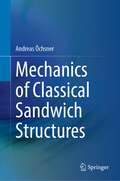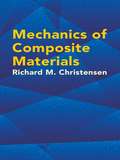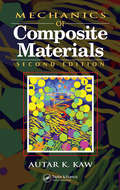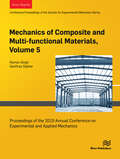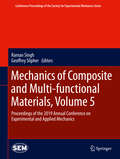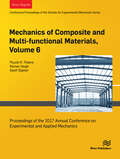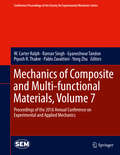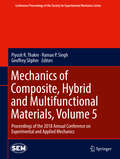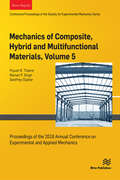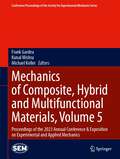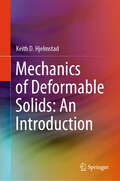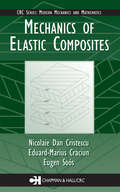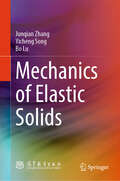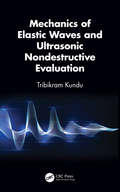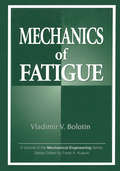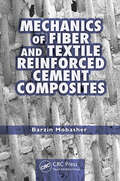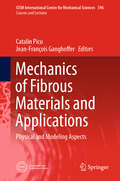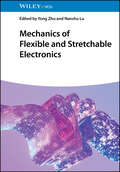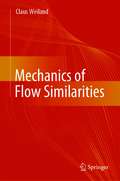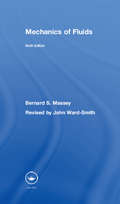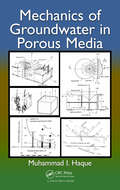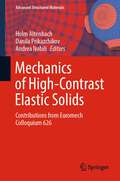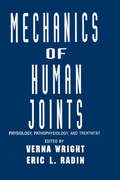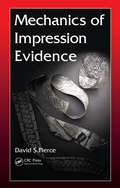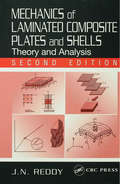- Table View
- List View
Mechanics of Classical Sandwich Structures
by Andreas ÖchsnerThis book treats the mechanical behavior of one-dimensional sandwich structures, a typicaloncept in the context of lightweight design. Such structures are composed of different constituent (e.g., layers) in order to achieve overall properties, which are better than for a single component alone. This book covers the basic mechanical load cases, i.e., tension/compression, bending, and shear. Based on this knowledge, different failure modes, i.e., plastic yielding, and global and local instabilities are investigated. In addition, an introduction to classic optimization problems, i.e., the formulation of an objective function (e.g., the weight of a structure) and corresponding restrictions, is included. The consideration here is limited to one- or two-dimensional design spaces, i.e., with a maximum of two design variables. For such simple cases, the minimum of the objective function can often be determined using analytical or graphical methods.
Mechanics of Composite Materials (Dover Civil and Mechanical Engineering)
by Richard M. ChristensenA comprehensive account of the basic theory of the mechanical behavior of heterogeneous media, this volume assembles, interprets, and interrelates contributions to the field of composite materials from theoretical research, laboratory developments, and product applications.The text focuses on the continuum mechanics aspects of behavior; specifically, it invokes idealized geometric models of the heterogeneous system to obtain theoretical predictions of macroscopic properties in terms of the properties of individual constituent materials. The wide range of subjects encompasses macroscopic stiffness properties, failure characterization, and wave propagation. Much of the book presumes a familiarity with the theory of linear elasticity; but it also takes into consideration behavior characterized by viscoelasticity and inviscid plasticity theories and problems involving nonlinear kinematics. Because of the close relationship between mechanical and thermal effects, the text also examines macroscopic, thermal properties of heterogeneous media.Although the primary emphasis centers on the development of theory, this volume also pays critical attention to the practical assessment of results and applications. Comparisons between different approaches and with reliable experimental data appear at main junctures. Suitable as a graduate-level text, Mechanics of Composite Materials is also a valuable reference for professionals.
Mechanics of Composite Materials (Mechanical and Aerospace Engineering Series)
by Autar K. KawIn 1997, Dr. Kaw introduced the first edition of Mechanics of Composite Materials, receiving high praise for its comprehensive scope and detailed examples. He also introduced the groundbreaking PROMAL software, a valuable tool for designing and analyzing structures made of composite materials. Updated and expanded to reflect recent advances in the
Mechanics of Composite and Multi-functional Materials, Volume 5: Proceedings of the 2019 Annual Conference on Experimental and Applied Mechanics
by Raman Singh Geoffrey SlipherMechanics of Composite, Hybrid, and Multifunctional Materials, Volume 5 of the Proceedings of the 2019 SEM Annual Conference & Exposition on Experimental and Applied Mechanics, the fifth volume of six from the Conference, brings together contributions to this important area of research and engineering. The collection presents early findings and case studies on a wide range of areas, including: Recycled Constituent Composites Damage Detection Advanced Imaging of Composites Multifunctional Materials Composite Interfaces Tunable Composites.
Mechanics of Composite and Multi-functional Materials, Volume 5: Proceedings of the 2019 Annual Conference on Experimental and Applied Mechanics (Conference Proceedings of the Society for Experimental Mechanics Series)
by Raman Singh Geoffrey SlipherMechanics of Composite, Hybrid, and Multifunctional Materials, Volume 5 of the Proceedings of the 2019 SEM Annual Conference & Exposition on Experimental and Applied Mechanics, the fifth volume of six from the Conference, brings together contributions to this important area of research and engineering. The collection presents early findings and case studies on a wide range of areas, including: Recycled Constituent Composites Damage Detection Advanced Imaging of Composites Multifunctional Materials Composite Interfaces Tunable Composites
Mechanics of Composite and Multi-functional Materials, Volume 6: Proceedings of the 2017 Annual Conference on Experimental and Applied Mechanics
by Piyush R. ThakreMechanics of Composite, Hybrid, and Multifunctional Materials, Volume 6 of the Proceedings of the 2017 SEM Annual Conference & Exposition on Experimental and Applied Mechanics, the sixth volume of nine from the Conference, brings together contributions to this important area of research and engineering. The collection presents early findings and case studies on a wide range of areas, including: Nano & Particulate Composites Recycled Constituent Composites Hybrid Composites Multifunctional Materials Fracture & Fatigue of Composites Novel Developments in Composites Mechanics of Composites.
Mechanics of Composite and Multi-functional Materials, Volume 7
by Pablo Zavattieri Gyaneshwar Tandon Raman Singh Piyush R. Thakre W. Carter Ralph Yong ZhuMechanics of Composite, Hybrid, and Multifunctional Materials, Volume 7 of the Proceedings of the 2016 SEM Annual Conference & Exposition on Experimental and Applied Mechanics, the seventh volume of ten from the Conference, brings together contributions to this important area of research and engineering. The collection presents early findings and case studies on a wide range of areas, including: Recycled-Constituent Composites Nano and Particulate Composites Damage Detection and Non-Destructive Evaluation of Composites Fracture and Fatigue Novel Developments in Composites Additive Manufacturing of Composites Mechanics of Graphene & Graphene Oxide Smart Materials Novel Developments in Composites Manufacturing and Joining of Composites
Mechanics of Composite, Hybrid and Multifunctional Materials, Volume 5: Proceedings Of The 2018 Annual Conference On Experimental And Applied Mechanics (Conference Proceedings of the Society for Experimental Mechanics Series)
by Piyush R. Thakre Raman P. Singh Geoffrey SlipherMechanics of Composite, Hybrid, and Multifunctional Materials, Volume 5 of the Proceedings of the 2018 SEM Annual Conference & Exposition on Experimental and Applied Mechanics, the fifth volume of eight from the Conference, brings together contributions to this important area of research and engineering. The collection presents early findings and case studies on a wide range of areas, including: Recycled Constituent Composites Nanocomposites Mechanics of Composites Fracture & Fatigue of Composites Multifunctional Materials Damage Detection & Non-destructive Evaluation Composites for Wind Energy & Aerospace Applications Computed Tomography of Composites Manufacturing & Joining of Composites Novel Developments in Composites
Mechanics of Composite, Hybrid and Multifunctional Materials, Volume 5: Proceedings of the 2018 Annual Conference on Experimental and Applied Mechanics
by Piyush R. Thakre Raman P. Singh Geoffrey SlipherMechanics of Composite, Hybrid, and Multifunctional Materials, Volume 5 of the Proceedings of the 2018 SEM Annual Conference & Exposition on Experimental and Applied Mechanics, the fifth volume of eight from the Conference, brings together contributions to this important area of research and engineering. The collection presents early findings and case studies on a wide range of areas, including: Recycled Constituent Composites Nanocomposites Mechanics of Composites Fracture & Fatigue of Composites Multifunctional Materials Damage Detection & Non-destructive Evaluation Composites for Wind Energy & Aerospace Applications Computed Tomography of Composites Manufacturing & Joining of Composites Novel Developments in Composites.
Mechanics of Composite, Hybrid and Multifunctional Materials, Volume 5: Proceedings of the 2023 Annual Conference & Exposition on Experimental and Applied Mechanics (Conference Proceedings of the Society for Experimental Mechanics Series)
by Michael Keller Frank Gardea Kunal MishraMechanics of Composite, Hybrid, and Multifunctional Materials, Volume 5 of the Proceedings of the 2023 SEM Annual Conference & Exposition on Experimental and Applied Mechanics, the fifth volume of five from the Conference, brings together contributions to this important area of research and engineering. The collection presents early findings and case studies on a wide range of areas, including:Advances in CompositesRecycled CompositesTunable MaterialsDamage Detection in CompositesMultifunctional CompositesFracture and Failure in Complex Materials
Mechanics of Deformable Solids: An Introduction
by Keith D. HjelmstadThis book provides a fresh approach to learning how solid bodies respond to loads, emphasizing clear derivations of the basic concepts from first principles. A consistent problem-solving framework fosters understanding by building and reinforcing the mathematical tools best suited to the task. Theoretical developments are augmented by an extensive set of MATLAB codes that not only show how to organize computations but also yield powerful tools for exploration and discovery. The book is aimed at engineering students at the sophomore level who have a background in calculus, linear algebra, and differential equations.
Mechanics of Elastic Composites
by Nicolaie Dan Cristescu Eduard-Marius Craciun Eugen SoósThis is a comprehensive, reader-friendly treatment of the theory behind modern elastic composite materials. The treatment includes recently developed results and methods drawn from research papers published in Eastern Europe that until now were unavailable in many western countries. Among the book's many notable features is the inclusion of more th
Mechanics of Elastic Solids
by Bo Lu Junqian Zhang Yicheng SongThis book entitled Mechanics of Elastic Solids is written as a textbook of the course “Elasticity” or “Theory of Elasticity” or “Elasticity Mechanics” for relevant engineering majors. It can also be used as a professional book for relevant technical persons. It mainly introduces elasticity theory, including stress analysis, deformation analysis, constitutive relations, elasticity model construction for actual problems, solutions for infinitesimal plane stress and strain problems, three-dimensional problems, multiphysics field problems, variation principle in elasticity, thin plate, and cylindrical shells. The rapid and continuous advancements in numerical methods and computer power have diminished the significance of certain analytical solutions in elasticity problems.. Therefore, this book simplifies some traditional contents such as the solution of plane problems and twist of cylinder. Instead, some new topics which are important for real-world problems are introduced, such as the accurate description of finite deformation, constitutive equations for small strain but large rotation problems, hyperelasticity, procedural steps and general methodologies for model construction of real-world problems, and multiphysics field problems. A plenty of examples is prepared in this book for comprehensive understanding.
Mechanics of Elastic Waves and Ultrasonic Nondestructive Evaluation
by Tribikram KunduSummary:This book presents necessary background knowledge on mechanics to understand and analyze elastic wave propagation in solids and fluids. This knowledge is necessary for elastic wave propagation modeling and for interpreting experimental data generated during ultrasonic nondestructive testing and evaluation (NDT&E). The book covers both linear and nonlinear analyses of ultrasonic NDT&E techniques. The materials presented here also include some exercise problems and solution manual. Therefore, this book can serve as a textbook or reference book for a graduate level course on elastic waves and/or ultrasonic nondestructive evaluation. It will be also useful for instructors who are interested in designing short courses on elastic wave propagation in solids or NDT&E. <P><P>The materials covered in the first two chapters provide the fundamental knowledge on linear mechanics of deformable solids while Chapter 4 covers nonlinear mechanics. Thus, both linear and nonlinear ultrasonic techniques are covered here. Nonlinear ultrasonic techniques are becoming more popular in recent years for detecting very small defects and damages. However, this topic is hardly covered in currently available textbooks. Researchers mostly rely on published research papers and research monographs to learn about nonlinear ultrasonic techniques. Chapter 3 describes elastic wave propagation modeling techniques using DPSM. Chapter 5 is dedicated to an important and very active research field – acoustic source localization – that is essential for structural health monitoring and for localizing crack and other type of damage initiation regions. <P><P>Features <li> Introduces Linear and Nonlinear ultrasonic techniques in a single book. <li>Commences with basic definitions of displacement, displacement gradient, traction and stress. <li> Provides step by step derivations of fundamental equations of mechanics as well as linear and nonlinear wave propagation analysis. <li> Discusses basic theory in addition to providing detailed NDE applications.• <li>Provides extensive example and exercise problems along with an extensive solutions manual.
Mechanics of Fatigue (Mechanical and Aerospace Engineering Series #11)
by Vladimir V. BolotinMechanics of Fatigue addresses the range of topics concerning damage, fatigue, and fracture of engineering materials and structures. The core of this resource builds upon the synthesis of micro- and macro-mechanics of fracture. In micromechanics, both the modeling of mechanical phenomena on the level of material structure and the continuous approach are based on the use of certain internal field parameters characterizing the dispersed micro-damage. This is referred to as continuum damage mechanics.The author develops his own theory for macromechanics, called analytical fracture mechanics. This term means the system cracked body - loading or loading device - is considered as a mechanical system and the tools of analytical (rational) mechanics are applied thoroughly to describe crack propagation until the final failure.Chapter discuss:preliminary information on fatigue and engineering methods for design of machines and structures against failures caused by fatiguefatigue crack nucleation, including microstructural and continuous modelstheory of fatigue crack propagationfatigue crack growth in linear elastic materials subject to dispersed damagefatigue cracks in elasto-plastic material, including crack growth retardation due to overloading as well as quasistationary approximationfatigue and related phenomena in hereditary solidsapplication of the theory fatigue crack growth considering environmental factorsunidirectional fiber composites with ductile matrix and brittle, initially continuous fiberslaminate compositesMechanics of Fatigue serves students dealing with mechanical aspects of fatigue, conducting research in fracture mechanics, structural safety, mechanics of composites, as well as modern branches of mechanics of solids and structures.
Mechanics of Fiber and Textile Reinforced Cement Composites
by Barzin MobasherAmong all building materials, concrete is the most commonly used-and there is a staggering demand for it. However, as we strive to build taller structures with improved seismic resistance or durable pavement with an indefinite service life, we require materials with better performance than the conventional materials used today. Considering the enor
Mechanics of Fibrous Materials and Applications: Physical and Modeling Aspects (CISM International Centre for Mechanical Sciences #596)
by Jean-François Ganghoffer Catalin PicuThe book explores the state of the art in the mechanics of fibrous media, providing an overview of the theoretical, modelling and practical aspects of designing and working with these materials. It also describes the advanced methods needed to handle their specific features, including the mechanics of generalized continua, dedicated homogenization methods and computational techniques, and presents applications of fibrous media to diverse fields and over a broad spectrum of scales, ranging from aeronautics to biomechanics.
Mechanics of Flexible and Stretchable Electronics
by Yong Zhu Nanshu LuDiscover a comprehensive overview and advances in mechanics to design the cutting edge electronics Soft electronics systems, which include flexible and stretchable electronics, are an area of technology with the potential to revolutionize fields from healthcare to defense. Engineering for flexibility and stretchability without compromising electronic functions poses serious challenges, and extensive mechanics and engineering knowledge is required to meet these challenges. Mechanics of Flexible and Stretchable Electronics introduces a range of soft functional materials and soft structures and their potential applications in the construction of soft electronics systems. Its detailed attention to the mechanics of these materials and structures makes it an indispensable tool for scientists and engineers at the cutting edge of electronics technology. Mechanics of Flexible and Stretchable Electronics readers will also find: A detailed summary of recent advances in the field Detailed treatment of structures including kirigami, serpentine, wrinkles, and many more A multidisciplinary approach suited to a varied readership Mechanics of Flexible and Stretchable Electronics is ideal for electronics and mechanical engineers, solid state physicists, and materials scientists, as well as the libraries that support them.
Mechanics of Flow Similarities
by Claus WeilandThe mechanics of similarity encompasses the analysis of dimensions, performed by various procedures, the gasdynamic similarity and the model technology. The analysis of dimensions delivers the dimensionless numbers by which specific physical challenges can be described with a reduced number of variables. Thereby the assessment of physical problems is facilitated. For fluid dynamics and all sorts of heat transfer the discipline of the mechanics of similarity was so important in the past, that the historical background is highlighted of all the persons who have contributed to the development of this discipline. The goal of the classical gasdynamic similarity was to find rules, which enables the aerodynamic engineer to perform transformations from existing flow fields to others, which meet geometrical and other specific flow field parameters. Most of these rules and findings do no longer play a role today, because a lot of potent experimental and theoretical/numerical methods are now available. This problem is addressed in the book. A recent investigation regarding the longitudinal aerodynamics of space vehicles has revealed, that there exist other astonishing similarities for hypersonic and supersonic flight Mach numbers. It seems, that obviously most of the longitudinal aerodynamics is independent from the geometrical configurations of the space vehicle considered, if a simple transformation is applied. A section of this book is devoted to these new findings.
Mechanics of Fluids
by John Ward-SmithAs in previous editions, this ninth edition of Massey’s Mechanics of Fluids introduces the basic principles of fluid mechanics in a detailed and clear manner. This bestselling textbook provides the sound physical understanding of fluid flow that is essential for an honours degree course in civil or mechanical engineering as well as courses in aeronautical and chemical engineering. Focusing on the engineering applications of fluid flow, rather than mathematical techniques, students are gradually introduced to the subject, with the text moving from the simple to the complex, and from the familiar to the unfamiliar. In an all-new chapter, the ninth edition closely examines the modern context of fluid mechanics, where climate change, new forms of energy generation, and fresh water conservation are pressing issues. SI units are used throughout and there are many worked examples. Though the book is essentially self-contained, where appropriate, references are given to more detailed or advanced accounts of particular topics providing a strong basis for further study. For lecturers, an accompanying solutions manual is available.
Mechanics of Groundwater in Porous Media
by Muhammad I. HaqueProvides a Balance between the Mathematical and Physical Aspects and the Engineering ApplicationsWritten for engineering and science students, Mechanics of Groundwater in Porous Media explains groundwater from both a mathematical and qualitative standpoint. The book builds up the theory of groundwater flow starting from basic physics and geometric
Mechanics of High-Contrast Elastic Solids: Contributions from Euromech Colloquium 626 (Advanced Structured Materials #187)
by Holm Altenbach Danila Prikazchikov Andrea NobiliThis book contains the most recent results in the area of strongly inhomogeneous composite structures, including layered materials as well as continua with microstructure. This collection of papers mainly arises from the Euromech Colloquium No. 626 on “Mechanics of High-Contrast Elastic Composites”. Focus is set on the peculiar mechanical behaviour caused by adjoining widely different structural elements (high contrast) in terms of material and/or geometrical properties.
Mechanics of Human Joints: Physiology: Pathophysiology, and Treatment
by Verna Wright and Eric L.RadinThis reference work brings together the biology, mechanics, neurophysiology and pathophysiology of diseased joints, illustrates available physiologically-based treatments for osteoarthrosis and explains how and when to use them.;Highlighting the most up-to-date biomechanical principles, Mechanics of Human Joints: discusses the functional anatomy of joints; relates the neurophysiology of joints to ligamentous reconstruction; elucidates the pathophysiology of osteoarthrosis; summarizes the latest information on muscle physiology and electromyography; examines the effect of vibration and impulsive loading on joint pathology; and explicates the principles of prosthetic joint replacement.
Mechanics of Impression Evidence
by David S. PiercePresenting the hard science increasingly required by courts to back up expert opinion in cases that hinge on impression evidence comparison, this book applies the methods of physics, chemistry, and engineering to analysis and interpretation of fingerprints, footwear and tire tread impressions, and bloodstains. Using easily accessible language, it shows the scientific method behind each of these discrete disciplines. It then combines and cross-references the knowledge within each to ultimately present a more generalist approach and thus a more informed judgment.
Mechanics of Laminated Composite Plates and Shells: Theory and Analysis, Second Edition (Applied and Computational Mechanics)
by J. N. ReddyThe second edition of this popular text provides complete, detailed coverage of the various theories, analytical solutions, and finite element models of laminated composite plates and shells. The book reflects advances in materials modeling in general and composite materials and structures in particular. It includes a chapter dedicated to the theory and analysis of laminated shells, discussions on smart structures and functionally graded materials, exercises and examples, and chapters that were reorganized from the first edition to improve the clarity of the presentation.
